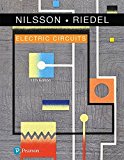
Electric Circuits Plus Mastering Engineering with Pearson eText 2.0 - Access Card Package (11th Edition) (What's New in Engineering)
11th Edition
ISBN: 9780134814117
Author: NILSSON, James W., Riedel, Susan
Publisher: PEARSON
expand_more
expand_more
format_list_bulleted
Concept explainers
Question
Chapter 14, Problem 13P
(a)
To determine
Find the value of the resistor for the RL high-pass filter using PSpice.
(b)
To determine
Find the value of the smallest load resistor that can be connected across the output terminals of the filter.
Expert Solution & Answer
Want to see the full answer?
Check out a sample textbook solution
Students have asked these similar questions
1. For the following logic gates:
a. Write a Truth Table and logic equation?
A
Y
A
A.
Y
A
Y
"0"
A
A
neotoof
"0">
Day
Y
"1"
A
ADY
DY
A
B
DD
A
B
b. What each of these gates represent?
2. Connect and draw the following digital logic equations:
a. Y=X+1
b. Y=X+X' = \
c. Y=X X'
d. Y=X 0
e. Y=XX'
f. Y=XOX
3. Prove that:
a. X(Y+Z)=XY+XZ
b. X+YZ=(X+Y)(X+Z)
c. (X+Y)'=X'Y'
d. (XY)'=X'+Y
e. X+XY=X
f. X(X+Y)=X
I need help with this problem and an step by step explanation of the solution from the image described below. (Introduction to Signals and Systems: Spectrum Representation)
I need help with this problem and an step by step explanation of the solution from the image described below. (Introduction to Signals and Systems: A complex Numbers)
Chapter 14 Solutions
Electric Circuits Plus Mastering Engineering with Pearson eText 2.0 - Access Card Package (11th Edition) (What's New in Engineering)
Ch. 14.2 - Prob. 1APCh. 14.2 - A series RL low-pass filter with a cutoff...Ch. 14.3 - Prob. 3APCh. 14.3 - Prob. 4APCh. 14.3 - Prob. 5APCh. 14.4 - Prob. 6APCh. 14.4 - Using the circuit in Fig. 14.22, compute the...Ch. 14.4 - Prob. 8APCh. 14.4 - Prob. 9APCh. 14.5 - Design the component values for the series RLC...
Ch. 14.5 - Prob. 11APCh. 14 - Prob. 1PCh. 14 - Consider the low-pass filter in Fig. P14.2, which...Ch. 14 - Use a 5 mH inductor to design a low-pass, RL....Ch. 14 - A resistor, denoted as Rl, is added in series with...Ch. 14 -
Use a 250 Ω resistor to design a low-pass passive...Ch. 14 - Consider the low-pass filler designed in Problem...Ch. 14 - Find the cutoff frequency (in hertz) of the...Ch. 14 - Prob. 8PCh. 14 - Use a 500 nF capacitor to design a low-pass...Ch. 14 - Prob. 10PCh. 14 - Consider the circuit shown in Fig. P14.11.
What is...Ch. 14 - Prob. 12PCh. 14 - Prob. 13PCh. 14 - Prob. 14PCh. 14 - Prob. 15PCh. 14 - Prob. 16PCh. 14 - Prob. 17PCh. 14 - Prob. 18PCh. 14 - Prob. 19PCh. 14 - Prob. 20PCh. 14 - Prob. 21PCh. 14 - Prob. 22PCh. 14 - Prob. 23PCh. 14 - Prob. 24PCh. 14 - Prob. 25PCh. 14 - Using a 50 nF capacitor in the bandpass circuit...Ch. 14 - Design a series RLC bandpass filter using only...Ch. 14 - Prob. 28PCh. 14 - Design a series RLC bandpass filter using only...Ch. 14 - Prob. 30PCh. 14 - Consider the circuit shown in Fig. P14.31.
Find...Ch. 14 - Prob. 32PCh. 14 - The purpose of this problem is to investigate how...Ch. 14 - The parameters in the circuit in Fig. P14.33 are R...Ch. 14 - Prob. 35PCh. 14 - Prob. 36PCh. 14 - Prob. 37PCh. 14 - Prob. 38PCh. 14 - Prob. 39PCh. 14 - Prob. 40PCh. 14 - Prob. 41PCh. 14 - Use a 500 nF capacitor to design a bandreject...Ch. 14 - Prob. 43PCh. 14 - Prob. 44PCh. 14 - Prob. 45PCh. 14 - The parameters in the circuit in Fig. P14.45 are R...Ch. 14 - Prob. 47PCh. 14 - Consider the series RLC circuit shown in Fig....Ch. 14 - Repeat Problem 14.49 for the circuit shown in Fig....Ch. 14 - Prob. 51PCh. 14 - Design a DTMF high-band bandpass filter similar to...Ch. 14 - Prob. 53P
Knowledge Booster
Learn more about
Need a deep-dive on the concept behind this application? Look no further. Learn more about this topic, electrical-engineering and related others by exploring similar questions and additional content below.Similar questions
- 5) Find the value of voltage V, and V₂ using Loop analysis. 5A + 4 34 ww 8 2 www 3A m 4 38 + 23V₂ 1/2 + ±) 12Varrow_forward4) Find the valve of voltage Vx using Loop analysis. 2A ( 1 3 w + 234 OV + 123arrow_forward3 Write but do not solve the set of Loop equations for this circuit www 4 १ह 15 ww 5 124 + ☹ 33 M 7A www 6 103 23 راح +arrow_forward
arrow_back_ios
SEE MORE QUESTIONS
arrow_forward_ios
Recommended textbooks for you
 Introductory Circuit Analysis (13th Edition)Electrical EngineeringISBN:9780133923605Author:Robert L. BoylestadPublisher:PEARSON
Introductory Circuit Analysis (13th Edition)Electrical EngineeringISBN:9780133923605Author:Robert L. BoylestadPublisher:PEARSON Delmar's Standard Textbook Of ElectricityElectrical EngineeringISBN:9781337900348Author:Stephen L. HermanPublisher:Cengage Learning
Delmar's Standard Textbook Of ElectricityElectrical EngineeringISBN:9781337900348Author:Stephen L. HermanPublisher:Cengage Learning Programmable Logic ControllersElectrical EngineeringISBN:9780073373843Author:Frank D. PetruzellaPublisher:McGraw-Hill Education
Programmable Logic ControllersElectrical EngineeringISBN:9780073373843Author:Frank D. PetruzellaPublisher:McGraw-Hill Education Fundamentals of Electric CircuitsElectrical EngineeringISBN:9780078028229Author:Charles K Alexander, Matthew SadikuPublisher:McGraw-Hill Education
Fundamentals of Electric CircuitsElectrical EngineeringISBN:9780078028229Author:Charles K Alexander, Matthew SadikuPublisher:McGraw-Hill Education Electric Circuits. (11th Edition)Electrical EngineeringISBN:9780134746968Author:James W. Nilsson, Susan RiedelPublisher:PEARSON
Electric Circuits. (11th Edition)Electrical EngineeringISBN:9780134746968Author:James W. Nilsson, Susan RiedelPublisher:PEARSON Engineering ElectromagneticsElectrical EngineeringISBN:9780078028151Author:Hayt, William H. (william Hart), Jr, BUCK, John A.Publisher:Mcgraw-hill Education,
Engineering ElectromagneticsElectrical EngineeringISBN:9780078028151Author:Hayt, William H. (william Hart), Jr, BUCK, John A.Publisher:Mcgraw-hill Education,

Introductory Circuit Analysis (13th Edition)
Electrical Engineering
ISBN:9780133923605
Author:Robert L. Boylestad
Publisher:PEARSON

Delmar's Standard Textbook Of Electricity
Electrical Engineering
ISBN:9781337900348
Author:Stephen L. Herman
Publisher:Cengage Learning

Programmable Logic Controllers
Electrical Engineering
ISBN:9780073373843
Author:Frank D. Petruzella
Publisher:McGraw-Hill Education

Fundamentals of Electric Circuits
Electrical Engineering
ISBN:9780078028229
Author:Charles K Alexander, Matthew Sadiku
Publisher:McGraw-Hill Education

Electric Circuits. (11th Edition)
Electrical Engineering
ISBN:9780134746968
Author:James W. Nilsson, Susan Riedel
Publisher:PEARSON

Engineering Electromagnetics
Electrical Engineering
ISBN:9780078028151
Author:Hayt, William H. (william Hart), Jr, BUCK, John A.
Publisher:Mcgraw-hill Education,
What is Filter & Classification of Filters | Four Types of Filters | Electronic Devices & Circuits; Author: SimplyInfo;https://www.youtube.com/watch?v=9x1Sjz-VPSg;License: Standard Youtube License